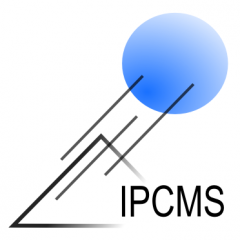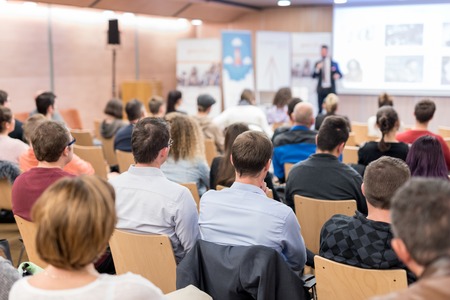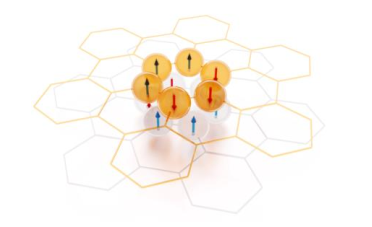Speaker : Amalio FERNÁNDEZ-PACHECO (Institute of Applied Physics, Vienna, Austria)
Seminar DMONS presented by Kshirsagar Aseem RAJAN
- Light tunable gas adsorption in functionalized metal-organic frameworks: insights from ab initio methods Metal-organic frameworks (MOFs) functionalized with azobenzene, a photo-isomerizing molecule, are capable of light stimulated capture and release of CO2. Using ab initio density functional theory (DFT) based atomistic modelling, the microscopic mechanism behind the light tunable gas uptake in azobenzene functionalized MOF-5 is revealed to be the blocking and unblocking of the metal-node, by distinct geometric configurations of azobenzene. A practical environment-consistent Bethe-Salpeter equation (BSE) approach is used for an accurate description of the photo-excitations of the photo switches to propose strategies for achieving high yields of photo switching. Our study also shows that electronic excitations in the prototype MOF-5 give rise to strongly bound states of electron-hole pair, analogous to organic insulators.
- Modulation of magnetization in BiFeO3 using circularly polarized light Dynamic and efficient control of the characteristic spin texture of multiferroic BiFeO3 is attractive for emerging quantum devices. Crystal-field d → d excitations localized on Fe atomic sites in BiFeO3 induce a complex interplay among the spin, charge and lattice degrees of freedom, making them relevant for manipulation of the spin texture. Ab initio methods based on the GW approximation and the BSE are used to characterize localized spin-flip excitations within Fe-3d shell. These excitations are strongly bound and appear deep within the electronic gap. Their spin-content and strong localization are protected by the antiferromagnetic ordering. The underlying crystal symmetry gives rise to chiral spin-flip exciton states localized on distinct Fe centers. These chiral excitons couple selectively to light of a particular circular polarization and are confined to a particular Fe magnetic sub-lattice. As a consequence, net spin- magnetization can be achieved using circularly polarized light coupling with exciton of desired chirality, thereby modulating the antiferromagnetic texture and giving rise to transient ferrimagnetism.
- Future directions: Understanding charge-lattice-spin coupling using ab initio methods
In transition-metal oxides, localized excitons can give rise to a complex interplay of spin-charge-lattice degrees of freedom. I intend to motivate and sketch an investigation of the coupling of these excitons with lattice motion and its relevance for optomechanical control.
Contact : Mébarek ALOUANI : mebarek.alouani@ipcms.unistra.fr
Webinar DMONS presented by Lorenzo Fratino
Connexion link :
https://cnrs.zoom.us/j/92376228043?pwd=MER4RzQ0eFdTZjNZV0hqK0ZQdkJ0QT09
Meeting id : 923 7622 8043 Password: MdC2024
Seminar DON presented by Sylvain LECLER
Sylvain Lecler (ICube)
Séminaire d’information sur l’Institut Photonique Grand Est : il s’agit d’une fédération entre plusieurs laboratoires du Grand Est, et un petit nombre d’entreprises actifs dans le secteur de la photonique.Les universités de Lorraine, Mulhouse, Strasbourg, l’UTT Troyes et Centrale Supelec ont signé l’accord de consortium.
Le but principal de la fédération est de promouvoir la photonique comme un axe scientifique et technologique majeure au niveau de la région, au même titre que les matériaux, l’environnement ou le bio-médicale. C’est un point important au moment des AAP de la région pour les co-financements de thèse ou de post-doc, D’autres opportunités sont les financements de projet par le FEDER.
Le directeur de l’Institut et Marc Sciamanna (Centrale Supelec, Metz). Hervé Rinner (ISL, Nancy) et Sylvain sont les co-directeurs.
Venez profiter de ce séminaire pour vous mettre au courant de cette nouvelle fédération régionale.
Webinar DMONS presented by Paul EYMÉOUD
Paul EYMÉOUD (Research Scientist at SiClade Technologies)
Lien de connexion par bbb unistra, le 12 mars 2024 à partir de 14h50 :
Webinar DMONS presented by M. Benjamin Bacq-Labreuil
Benjamin BACQ-LABREUIL (Institut Quantique de l’Université de Sherbrooke – Canada)
Abstract : High-temperature n-layer cuprate superconductors have the remarkable universal feature that the maximum transition temperature Tc is always obtained for the tri-layer compound. It remains unclear how the recent breakthroughs, highlighting the relation of the charge transfer gap (CTG) and the spin exchange J with the pairing density, can be related to this universality. By integrating an exact diagonalization solver to a density functional theory (DFT) plus cluster dynamical mean-field theory (CDMFT) framework, we were able to carry charge self-consistent DFT+CDMFT calculations for n =1-5 multilayer cuprates. Remarkably, the undoped compounds already host a peculiar behavior as a function of n: the CTG first decreases until reaching a minimum at n=3, and then stabilizes. The CTG is smaller in the inner CuO2 planes, and consequently the spin exchange J is larger as compared to the outer planes, which corroborates the experimental evidence of stronger antiferromagnetic spin fluctuations in the inner planes. We trace back the miscroscopic origin of these observations to the existence of interstitial conduction states confined between the CuO2 layers which favor the inner planes. Our work paves the way towards ab initio material-specific predictions of the superconducting order parameter.
Contact : Mébarek ALOUANI : mebarek.alouani@ipcms.unistra.fr
Connexion links on March 5th, 2024 from 14h50 :
https://cnrs.zoom.us/j/94911816568?pwd=c0JoY2EyU1VJOG5SN2NsQXNDRG81Zz09
Meeting ID: 949 1181 6568
Secret code: 0FaFbn
Seminar Axis 1 presented by Mattia Udina
Speaker: Mattia Udina, La Sapienza Roma
The abstract is available there.
Seminar DCMI – Axis 5 presented by Kévin DEDECKER
Kevin Dedecker (Institut Européen des Membranes (IEM); CNRS, ENSCM, Univ Montpellier)
Seminar Axis 3 presented by Dr. Maurizio Mastropasqua Talamo
Dr. Maurizio Mastropasqua Talamo (Laboratoire Moltech-Anjou, Université d’Angers)
Abstract :
Starting from initial purposes of molecular recognition, the study of chiral pi-conjugated molecules and supramolecular assemblies have led over time to a deeper understanding of chirality-related properties which do not only rely upon geometric pairing but also involve polarization in light-matter interaction and spin selectivity in charge transport. These new properties have boosted the interest in the development of chiral organic semiconductors for advanced optoelectronics applications.
Many asymmetric synthetic techniques which are particularly important in the field of pharmaceutical synthesis, can enable the practical modification of pi-conjugated scaffolds with various stereogenic motifs, resulting in molecular semiconductors and chromophores showcasing diverse chirality-related properties.
Some examples of asymmetric modification of molecular semiconductors and chromophores will be given in this lecture along with a discussion about chirality-related properties observed within the newly synthesized materials.
Seminar IPCMS presented by Dr. Laurence CROGUENNEC
Dr. Laurence CROGUENNEC (Institut de Chimie de la Matière Condensée de Bordeaux)
Directrice de recherche CNRS, directrice adjointe de l’ICMCB
Abstract :
Known from all chemists for decades, the sodium-ion battery technology was dethroned in the 1980s by the lithium-ion battery that offered better performance. The major interest of sodium is to be a sustainable resource in comparison to lithium. The technology is thus back on the scene as an ecological, economical and reliable alternative to the lithium-ion battery. I will present the challenges of this research field, and highlight some of our results. I will show how we were able to (i) discover a new family of NASICON structural type materials NaxV2(PO4)3, and (ii) demonstrate how the chemistry of mixed anions and in particular the competition between the ionic bond V-F and the very covalent vanadyle-type bond V=O has an impact on the properties of Na3V2(PO4)2F3-yOy. I will demonstrate that only the in-depth control of the relationship synthesis/composition/atomic and electronic structure allows to tune the properties in the battery. I will illustrate also that monitoring in situ and operando, especially at large scale facilities, the synthesis of electrode materials and their evolution when used in batteries is essential. Changes in the composition and structure of the materials must be studied in their environment (in situ), and in real time (operando) during their preparation or operation of the battery because they are most often in conditions out of equilibrium. The experiments thus conducted allow to study the dynamics of reactions, essential for the understanding of the material and optimization of its performance in the electrochemical storage system.


